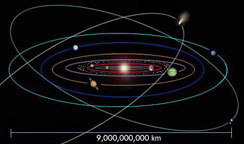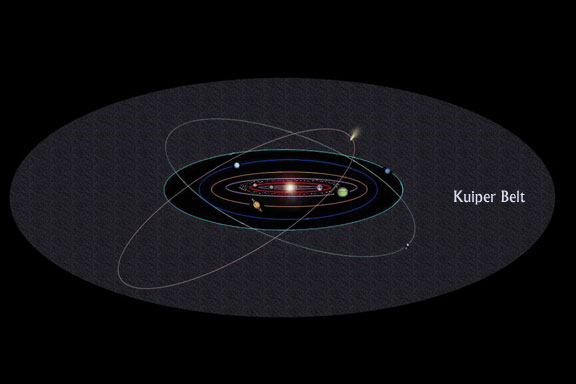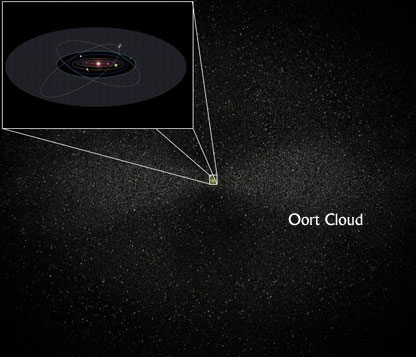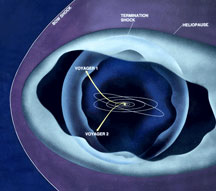
The Solar System
About the Image

The image of the Solar System was made using real images of the planets. It is not to scale; the Solar System is so large with respect to the size of the planets, that to fit it on the screen, the planets would have to be small dots. Thus, some artistic license is involved. However, the planets are in the correct order. Also shown is comet Hale-Bopp, photographed by the author.
One way to help visualize the relative distances in the solar system is to imagine a model in which the solar system is reduced in size by a factor of a billion (109). The Earth is then about 1.3 cm in diameter (the size of a grape). The Moon orbits about a foot away. The Sun is 1.5 meters in diameter (about the height of a man) and 150 meters (about a city block) from the Earth. Jupiter is 15 cm in diameter (the size of a large grapefruit) and 5 blocks away from the Sun. Saturn (the size of an orange) is 10 blocks away; Uranus and Neptune (lemons) are 20 and 30 blocks away. A human on this scale is the size of an atom; the nearest star would be over 40,000 km away!
Distance Information
Distances in the solar system are commonly measured in Astronomical Units (AU). An AU is simply the average distance between the Earth and the Sun. Because the Earth's orbit around the Sun is an ellipse, the Earth is not always the same distance from the Sun. An AU is equal to ~149,600,000 km. It takes 8 minutes for light to travel from the Sun to the Earth,traveling at the speed of light, of course.
The Moon, the closest solar system body to us, is about 400,000 km away from the Earth, which means it takes about 2 seconds for radio signal from Earth to reach the Moon and travel back. You could hear this delay in communications between the Apollo astronauts and the ground control.
The most distant planet from the Earth isn't Pluto anymore. Pluto was reclassified as a "dwarf planet"; a dwarf planet is not just a small planet - it belongs to a separate class of objects. Neptune is now the outer-most planet in our solar system. Its orbit places it at ~ 4,500,000,000 km or 30 AU from the Sun.
Pluto is still an interesting member of the solar system, however - its orbit is actually very eccentric and takes Pluto 4,400,000,000 - 7,400,000,000 km (30 - 49 AU) from the Sun. Pluto's orbit is also inclined with respect to the planets and doesn't fall within the same plane. As a result of its eccentricity, Pluto occasionally comes closer to the Sun than the planet Neptune does!
The Outer Reaches of the Solar System
There are objects belonging to our Solar System that are even farther than the orbit of our planets. The Kuiper Belt is a disk-shaped region past the orbit of Neptune, roughly 4,400,000,000 to 14,900,000,000 km (30 to 100 AU) from the Sun, that consists mainly of small bodies which are the remnants from the Solar System's formation. It also contains at least one dwarf planet - Pluto. Pluto is indeed now considered to be a member of the Kuiper Belt - the largest object belonging to it, in fact! Like other members of the Belt, it is composed primarily of rock and ice and is relatively small. There is an excellent discussion on why Pluto was reclassified from "planet" to "dwarf planet" and Kuiper Belt Object (KBO) here. The Kuiper Belt is also believed to be the source for short-period comets (ie, those that take less than 200 years or orbit).

Pluto is not the only dwarf planet in our solar system - Eris, 27% more massive than Pluto, was discovered in 2003. Eris and its moon Dysnomia have a current distance from the Sun of 97 AU, which is nearly 3 times as far from the Sun as Pluto is. Eris is part of a region of space beyond the Kuiper Belt known as the scattered disc. The scattered disc is sparesely populated with icy minor planets. These so-called Scattered Disc Objects or SDO's are among the most distant and thus the most cold objects in the solar system. The innermost portion of the scattered disc overlaps with the Kuiper Belt, but its outer limits extend much farther away from the Sun and farther above and below the ecliptic than Belt. Although their origin is not completely understood, it is thought that Scattered Disc Objects were previously members of the Kuiper Belt, which got ejected into eccentric, scattered orbits through close encounters with Neptune.
From the surface of a Scattered Disc Object, the Sun would look like little more than an exceptionally bright star.
In 1977, the Voyager satellites were launched - and after tours that took them near the outer planets in our Solar System, they continued going, with a new mission to explore interstellar space. As of 2007, Voyager 1 was nearing the heliopause - the region where the Sun's dominance of the environment ends and interstellar space begins. This made Voyager the farthest human-made object, at more than three times the distance of Pluto. Voyager 1 continues to move away from us at 17.3 kilometers per second.
Moving still further away from the Sun, we reach the Oort Cloud. In 1950, astronomer Jan Oort proposed that long-period comets reside in a vast spherical cloud residing 5,000 to 50,000+ AU from the Sun, at the outer reaches of the Solar System. This major reservoir of comets has come to be known as the Oort Cloud. The Kuiper belt can be described as disc or doughnut-shaped, but the Oort cloud is more like a very thick "bubble" that surrounds the entire solar system, reaching about half-way from the Sun to the next nearest star. Statistics imply that it may contain as many as a trillion (1012) comets. Unfortunately, since the individual comets are so small and at such large distances, we have no direct evidence for the Oort Cloud. The Oort Cloud is, however the best theory to explain how long-period comets exist.

50,000 AU seems like a very large distance from the Sun - but the nearest star to us is over 271,000 AU away!
How Do We Calculate Distances of This Magnitude?
Johannes Kepler, born in 1571, was the first to explain the motions of the planets in the sky, by realizing that the planets revolved around the Sun - and that their orbits were actually ellipses, not perfect circles. He also knew that the movement of the planets around the Sun could be described by physics - and in mathematical terms. The closer the planet was to the Sun, the faster it moved. Conversely, farther planets orbited the Sun more slowly. Knowing this, he was able to connect the average distance of a planet from the Sun with the time it takes that planet to orbit the Sun once.
Though he wasn't able to come up with distance measurements in kilometers, Kepler was able to order the planets by distance and to figure out their proportional distances. For example, he knew that Mars was about 1.5 times farther from the Sun than the Earth.
Parallax
If you hold your finger in front of your face, close one eye and look with the other, then switch eyes, you'll see your finger seem to "shift " with respect to more distant objects behind it. This is because your eyes are separated from each other by a distance of a few inches - so each eye sees the finger in front of you from a slightly different angle. The amount your finger seems to shift is called its "parallax".

In the late 17th century, Giovanni Cassini used the parallax technique to measure the distance to Mars. Cassini knew that a larger parallax would be easier to measure - but this required a larger baseline (ie, the baseline would be like the distance between your eyes). He took measurements of the position of Mars from Paris and sent a fellow astronomer to French Guiana in South America to do the same. This gave him a baseline of several thousand kilometers - using geometry, he was able to calculate a distance for Mars that is only 7% off today's more precise measurements! (Try this page for the mathematics for the calculation.)
Even with modern technology, measuring distances by parallax isn't trivial - and the errors can be big - as we can see from Cassini's measurement of the Earth-Mars distance.
Radar
Oneof the most accurate ways to measure the distances to the planets is by bouncing radar off them, or sending a spacecraft there, which can send a radio signal back to the Earth that can be timed. Radar is essentially microwave electromagnetic radiation (microwaves fall under the radio spectrum). Since electromagnetic radiation, in all of its forms, is light, we know that radar travels at the speed of light - 2.99 x 105 km/s. Simply, distance traveled is equal to the time multiplied by the velocity. If we bounce radar off a planet, and measure the time it takes the signal to go there and back, we can use this information to calculate the distance of the planet.
Distant Solar System Objects
There are other modern methods to calculate the distances to objects on the fringes of our Solar System, like Kuiper Belt or Scattered Disc Objects. However, these techniques are often based on those Kepler employed! Several observations of the object's position in the sky are recorded, which are then used to determine the orbit of the object - then the position of the object along each point can be calculated. Nowadays, even home PCs are powerful enough that there are some advanced amateur astronomers who not only discover comets and asteroids but determine their orbits.
Why Are These Distances Important To Astronomers?
Knowing the distances to objects in our solar system, tells us how big it is - and how far away our neighboring planets are. How far the planets are from the Sun is particularly meaningful - here's why.
If youplace a candle at arm's length in an otherwise dark room, you'll see a bright flame. If you stand twice as far from the candle, you will see that it is now a quarter as bright as before. When you increase the distance by a factor of 2 (or 3 or 4, ...), the same amount of light has spread to an area 4 times (or 9 or 16, ...) bigger. This means the amount of light per unit area is 1/4 (or 1/9, 1/16, ...); since our eyes have the same area no matter how far the candle is, the brightness we perceive is also decreased by the same factor.
Similarly, the distance from the Sun determines how much sunlight a planet receives. On Mars, which is 1.6 AU from the Sun (AU being the average Sun-Earth distance), the sunlight is about 2.5 times weaker than on Earth. That is the major reason why it is so cold on Mars, so cold that water does not exist as liquid on the Martian surface today. On Venus, which is 0.7 AU from the Sun, the sunlight is twice as intense as on Earth. This (combined with the greenhouse effect of its thick atmosphere) makes Venus a boiling hot place, unsuitable for human habitation. This leads to the idea of a 'habitable zone' --- for a star of a given brightness, you can determine the approximate range of distances a planet has to be for liquid water to exist. Life as we know it will not be able to evolve on a planet outside such a habitable zone.
Travel Time
Cassini, launched in 1997, is a spacecraft that was bound for Saturn. It traveled towards Saturn at 18,720 miles per hour, or 5.2 kilometers per second. Using gravitational assists to aid it, Cassini still took 6.7 years to reach Saturn. If Cassini left Saturn and continued on to Pluto at a rate of 5.2 km/s, it would arrive there about 27 years later.
For detailed, up-to-date, information about our Solar System, see the wonderful "Nine Planets" page, written by Bill Arnett. See also NASA JPL's page on the planets and A Comprehensive Guide to Our Solar System. For more information about the Oort Cloud and the Kuiper Belt, see Phil Plait's Bad Astronomy page.



